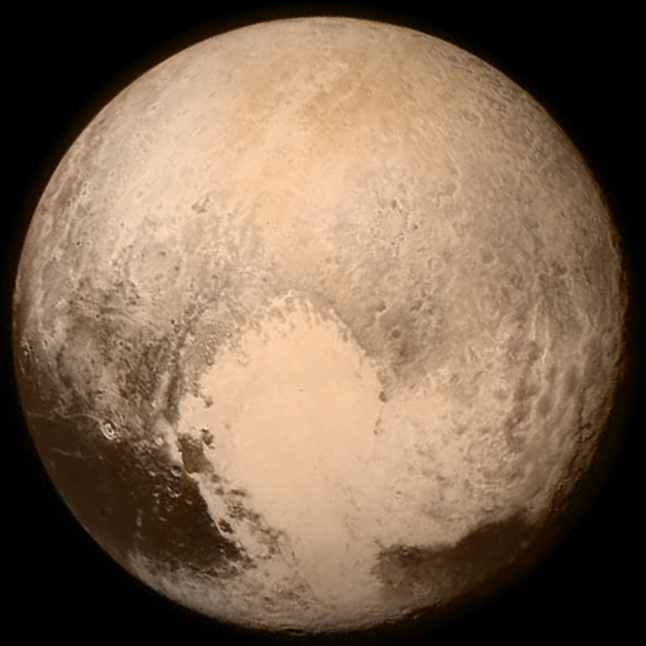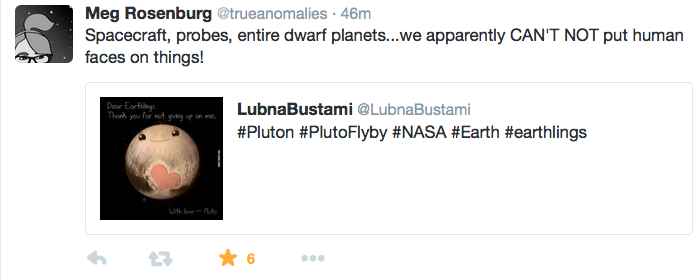July 16, 2015, by Brigitte Nerlich
Pluto and pareidolia
 As everybody knows by now, New Horizons has been flying past Pluto and has beamed down astonishing images. One of these shows a peach or bronze coloured planetary object with a lighter pattern on the side that I first saw as a ‘heart’. Many others did so too, including NASA (it will now name this region after Pluto’s original discoverer Clyde Tombaugh). Then I came across images of Pluto, the Disney dog, superimposed on this heart-shape and now I can’t see the image without thinking about Pluto the dog.*
As everybody knows by now, New Horizons has been flying past Pluto and has beamed down astonishing images. One of these shows a peach or bronze coloured planetary object with a lighter pattern on the side that I first saw as a ‘heart’. Many others did so too, including NASA (it will now name this region after Pluto’s original discoverer Clyde Tombaugh). Then I came across images of Pluto, the Disney dog, superimposed on this heart-shape and now I can’t see the image without thinking about Pluto the dog.*
Finding Pluto, finding us
I had just used this hilarious vine, an animation of Pluto the dog projected onto Pluto the ‘planet’, while preparing a lecture on how we see science through the lens of culture, when I came across this tweet by Meg Rosenberg, a historian of science (especially planetary science), who blogs at True Anomalies.
 Why do we anthropomorphise (or dog-ise or duck-ise) pieces of rock or assemblages of metal and wire (sorry, Sarcastic Rover), such as the Mars Curiosity Rover or Philae or Mars or 67P or, indeed, Pluto? Why do we see faces and other features, even a man, in or on the moon? Why do we see a comet like a rubber duck? Why do we see Philae waking up, just a month ago? Why does the Mars rover call ‘itself’ Johnny Five? Why do we see faces and other features on Mars? Why do we see Pluto on Pluto? Why do we see Pluto like Mars?…
Why do we anthropomorphise (or dog-ise or duck-ise) pieces of rock or assemblages of metal and wire (sorry, Sarcastic Rover), such as the Mars Curiosity Rover or Philae or Mars or 67P or, indeed, Pluto? Why do we see faces and other features, even a man, in or on the moon? Why do we see a comet like a rubber duck? Why do we see Philae waking up, just a month ago? Why does the Mars rover call ‘itself’ Johnny Five? Why do we see faces and other features on Mars? Why do we see Pluto on Pluto? Why do we see Pluto like Mars?…
So I started to think with my fingers, as one does, and found that there is actually a word for this tendency: pareidolia!
Pareidolia
Pareidolia, is, it seems, “the imagined perception of a pattern or meaning where it does not actually exist” (Collins Dictionary). As far back as 1965 Carl Sagan had talked about pareidolia and put forward an evolutionary explanation. He wrote in his 1995 book, The Demon-Haunted World, “As soon as the infant can see, it recognizes faces, and we now know that this skill is hardwired in our brains. Those infants who a million years ago were unable to recognize a face smiled back less, were less likely to win the hearts of their parents, and less likely to prosper.” (Quoted in this article on pareidolia)
More recently, in 2013, a project called Googlefaces was launched which involved an “independent searching agent hovering the world to spot all the faces that are hidden on earth”. There is even a Pinterest board on pareidolia – it should add Pluto!
Metaphors, mappings and meanings
As people know, I am a bit of a metaphor fanatic. Metaphors establish (quite fragile and slippery but useful nevertheless) bridges between the known and familiar and the unknown and the unfamiliar, the human and the non-human, the human world and the natural world. They establish a rapport between disparate domains of knowledge, but also between us (subjects), and the world (objects). Part of that process it seems turns the world into us, turns objects into subjects, maps who we are onto what they are and vice versa. In a way we turn the world around us into our world. We create meaning.
As one of the researchers on the Googlefaces project team said: “…pareidolia is a consequence of the brain’s information processing systems. The brain is constantly sifting through random lines, shapes, surfaces and colours, says Joel Voss, a neuroscientist at Northwestern University. It makes sense of these images by assigning meaning to them – usually by matching them to something stored in long-term knowledge. But sometimes things that are slightly ‘ambiguous’ get matched up with things we can name more easily – resulting in pareidolia”.
The fun side of pareidolia
I am, of course, not the only one having made the link between Pluto and pareidolia! The best take on this can be found in the latest xkcd comic. As explained here, this “comic was posted on Tuesday, July 14th 2015, in honor of the New Horizons deep space probe making its flyby at Pluto, thus breaking the typical Monday/Wednesday/Friday cycle for the xkcd comics. Randall has taken one of the probes [sic] images of Pluto (the largest released at the time of publishing), and outlined humorous examples of pareidolia on top of it.”
The serious side of pareidolia
Pareidolia can be fun, but it also has a more serious side. Some scholars, such as Stewart Guthrie, author of ‘Faces in the cloud: A new theory of religion’, claim that “religion can best be understood as systematic anthropomorphism–that is, the attribution of human characteristics to nonhuman things and events”. Others, like Lucy Sullivan, have dissected the impact of an anthropomorphizing and popularizing metaphor, the ‘selfish gene’, which has changed biological thinking quite fundamentally and not always for the better. So we have to be careful. But, for the moment, I am enjoying the fun.
*I drafted this post yesterday afternoon before these detailed pictures came in – they are stunning but perhaps less easily pareidolised (let ‘Googlefaces’ have a try)!
(This is a post in a series on ‘space exploration‘ – if you like, making space public)
Image: Pluto (Wikimedia Commons)

[…] still savouring the Pluto flyby on my twitter stream last week, I came across some tweets saying things like this: “It is a truth […]